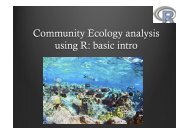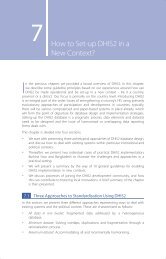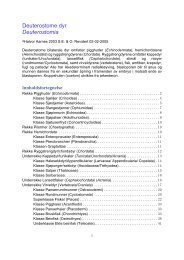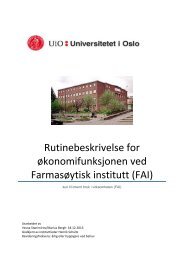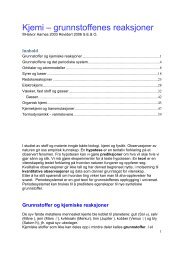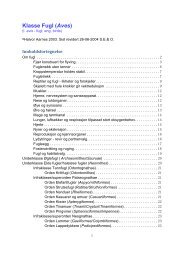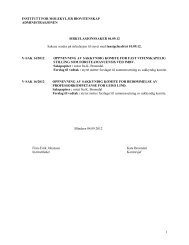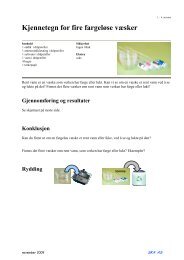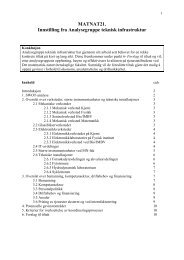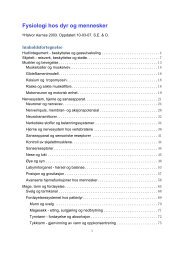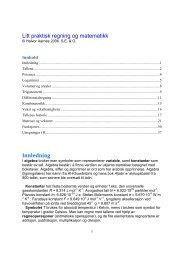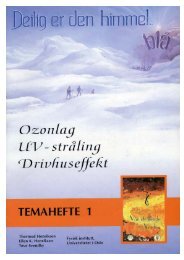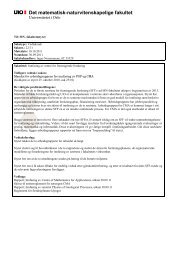MERG - Universitetet i Oslo
MERG - Universitetet i Oslo
MERG - Universitetet i Oslo
Create successful ePaper yourself
Turn your PDF publications into a flip-book with our unique Google optimized e-Paper software.
Impact factor<br />
The two papers published in 2011 with highest impact<br />
factor (IF) were:<br />
• Buntgen U, Kauserud H, Egli S. 2011. Linking climate<br />
variability to mushroom productivity and phenology.<br />
Frontiers in Ecology and the Environment, in press<br />
(IF: 8.8)<br />
• Eastwood et al. 2011. The Plant Cell Wall‚ Decomposing<br />
Machinery Underlies the Functional Diversity<br />
of Forest Fungi. Science 333, 762 (IF: 31)<br />
All 2011 publications see the appendix 2.<br />
Highly cited papers<br />
In 2011 two articles were on the top cited articles in two<br />
international peer reviewed journals. Burki et al. 2008<br />
and 2009 are currently at top cited list in Biology Letters<br />
Genome Biology and Evolution.<br />
• Burki, F; Shalchian-Tabrizi, Kamran & Pawlowski, J<br />
(2008). Phylogenomics reveals a new ‘megagroup’<br />
including most photosynthetic eukaryotes. Biology<br />
Letters. ISSN 1744-9561. 4, s 366- 369 . doi:<br />
10.1098/rsbl.2008.0224<br />
• Burki, Fabien; Inagaki, Yuji; Bråte, Jon; Archibald,<br />
John M; Keeling, Patrick J; Cavalier-Smith, Thomas;<br />
Sakaguchi, Miako et al. (2009). Large-Scale Phylogenomic<br />
Analyses Reveal That Two Enigmatic Protist<br />
Lineages, Telonemia and Centroheliozoa, Are Related<br />
to Photosynthetic Chromalveolates. Genome<br />
Biology and Evolution. ISSN 1759-6653. 1(1), s<br />
231-238 . doi: 10.1093/gbe/evp022<br />
research and serVice aPPlications<br />
In 2011 <strong>MERG</strong> staff took part in 11 larger grant applications<br />
to national and international grant offices. These<br />
are the following highlight:<br />
Centre of Excellence (CoE)<br />
<strong>MERG</strong> applied for a Centre of Excellence named Centre<br />
for Integrative Microbiology (CIM) together with three<br />
other microbial biology research groups at the University<br />
of <strong>Oslo</strong> (Glyconor, LaMDa, <strong>MERG</strong> and Tone Tønjumgroup)<br />
and external collaborators to maximize the potential<br />
synergies. The assessment gave an overall score<br />
excellent. The outcome of the prequalification round will<br />
be announced in May 2012.<br />
ERC starting grant application<br />
In November 2011 Håvard Kauserud submitted an ERC<br />
starting grant application to the European Research<br />
Council entitled “Linking microbial communities in boreal<br />
forest soils to plant diversity and productivity – a<br />
metagenomics approach”. The goal of this project is to<br />
make fundamental progress in the understanding of the<br />
community ecology of microorganisms in boreal forest<br />
soils and how they are organized spatiotemporally. The<br />
diversity, composition and activity of microbial communities<br />
will be related to the diversity and productivity of<br />
co-occurring plants.<br />
Grants from Research Council of Norway and UiO<br />
Project leader Dag Klaveness, got funded the project:<br />
“X-cell parasites: an emerging threat to marine fish”. This<br />
project is a collaboration with Kamran Shalchian-Tabrizi,<br />
Mark Freeman, University of Malaya, David Bass, Natural<br />
History Museum, London and Håkon Hansen, Norwegian<br />
Veterinary Institute, Norway.<br />
The project ”Regulatory RNA and the origin of animal<br />
multicellularity” got funded by an UiO PhD position (Ralf<br />
Neumann) and a, postdoc position to Jon Bråte. The<br />
projects aims to investigate whether the RNAi machinery<br />
was lost from the genomes of single-celled ancestors<br />
of animals multiple times and if the miRNA pathway<br />
evolved independently in animals with respect to other<br />
eukaryotic supergroups.<br />
All scientific project see the appendix 1<br />
high PerforMance coMPuting<br />
The capabilities of the Bioportal will be expanded to meet<br />
the Life Science users’ computational needs. The major<br />
objective with the requested project from NOTUR is to<br />
implement the Galaxy infrastructure at the computational<br />
resources at UiO and develop this system to handle<br />
jobs from the Bioportal. Porting jobs from the Bioportal<br />
to the Galaxy system will have several advantages. This<br />
project is a collaboration between BIO, USIT and CLSi.<br />
eValuation<br />
In the BIO-fag evaluation from 2010 the research program<br />
<strong>MERG</strong> got a good – very good score. The BIO-fag<br />
evaluation is based on achievement from 2000-2009.<br />
infrastructure<br />
The Microlab facility at Department of Biology was<br />
opened in December 2011. The facility is designed and<br />
managed by <strong>MERG</strong>. The Microlab is established for<br />
storage and growth of microbial cells of prokaryotes<br />
and eukaryotes species a well as virus, and other kinds<br />
of cell tissues from multicellular organisms such as animals<br />
and plant. The Microlab will be used for research<br />
on algea, fungi, protozoa, several bacteria strains and<br />
salmon cells. More about this infrastructure see <strong>MERG</strong><br />
web-pages.<br />
new web-Pages<br />
New <strong>MERG</strong> web pages have been made - see<br />
http://www.merg.uio.no<br />
new coMMunication Profile for Merg<br />
New profile including power-points, posters, newsletters,<br />
colour pallet and elements was ready September<br />
2011. This is intended for <strong>MERG</strong> internal and external<br />
use.<br />
all achieVeMent 2011 in the JiPPi rePort<br />
Activities in <strong>MERG</strong> has been reported in the JIPPI, more<br />
information about JIPPI and the activities in <strong>MERG</strong> 2011,<br />
see appendix 2.




